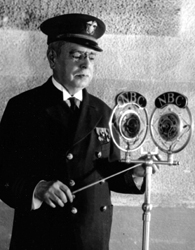John Philip Sousa is the American composer behind such marching band classics as “The Stars and Stripes Forever” and “Semper Fidelis.”
John Philip Sousa’s Early Days
John Philip Sousa was born in Washington D.C., on November 6, 1854, the third of 10 children. His father, a Spanish immigrant, played trombone in the United States Marine Band (the “President’s Own” band) and enrolled Sousa in music lessons at the age of six. Sousa studied voice, violin and flute, among other instruments, at a conservatory. By the time he graduated at the age of 11, he had won every available award at the school. Upon graduating, Sousa began conducting his own small dance-music orchestra. Sousa became famous in D.C. for his talents as a young conductor leading a group of grown men. When he was 12 years old, Sousa began studying with European-trained classic musician George Felix Benkert. While taking lessons, Sousa also performed regularly with Benkert’s orchestra, the Washington Orchestral Union, and in a string quartet at the home of the Assistant Secretary of State William Hunter, who became a valuable advocate for Sousa’s musical career.
In addition to his studies, Sousa enlisted as an apprentice to the U.S. Marine Band when he was 13 years old, at his father’s insistence. Sousa spent the next six years with the Marine Band, during which time he wrote his first composition, “Moonlight on the Potomac Waltzes.” In 1875, Sousa began touring as a violinist in a theater troupe before landing a lead position in the orchestra of Jacques Offenbach in Philadelphia. Over the next four years, Sousa developed a career as a music conductor in theater, including a Broadway adaptation of Gilbert and Sullivan’s “H.M.S. Pinafore.”
Sources in this Story
- Naxos: Sousa, John Philip: Biography
- PBS: A Capitol Fourth: The March King
- The United States Marine Band: Our History: John Phillips Sousa
- The New York Times: John Philip Sousa, Band Leader, Dies in Hotel at Reading
- Britannica Online Encyclopedia: John Philip Sousa
Sousa’s Notable Accomplishments
Sousa and his new wife, Jane van Middlesworth Bellis, settled in Washington, D.C., in 1880, so Sousa could begin his post as the new director of the U.S. Marine Band. He led the Marine Band until 1892, composing several famous works during this time, most notably “Semper Fidelis” (1888), which became the official anthem of the U.S. Marines. Sousa also wrote the now legendary “Washington Post March” (1889), which became a huge hit in America and Europe, and earned Sousa the nickname “The March King.” During this time, the Marine Band made its first recordings for the newly invented phonograph. In 1891, President Harrison permitted Sousa and the Marine Band to embark on their first national tour, a tradition that has continued to this day. A second successful tour in 1892 inspired Sousa to retire from the Marine Band and form his own civilian band.
Sousa continued to enjoy success, taking his 100-musician band on frequent national tours throughout his career. In 1900, Sousa’s band received an enthusiastic response at the Paris Exhibition. The band would go on to make five European tours. In 1910, Sousa and his band embarked on a world tour, covering 60,000 miles. In 1929, after years of apprehension, Sousa made his first radio appearance. During his years as the conductor of his private band, Sousa composed several more legendary marches, including “The Liberty Bell” (1893) and “The Stars and Stripes Forever” (1897). His last public appearance was in April 1931 at the Metropolitan Opera House. Sousa died of a heart attack on March 6, 1932, in Reading, Pennsylvania at the age of 77.
The Man and his Work
- “Sousa’s Greatest Hits”: United States Marine Band
- “Sousa Marches: Stars and Stripes Forever”: Philip Jones Brass Ensemble
- “Greatest Hits of Sousa’s Band”: Original Recordings Performed by the John Philip Sousa Band
- “Hands Across the Sea: The Band of the Grenadier Guards: Sousa Marches” (DVD)
- “John Philip Sousa: American Phenomenon” by Paul E. Bierley
The Rest of the Story
Sousa left behind a legacy of more than 300 musical compositions, including 136 marches and 11 operettas. He also wrote three popular novels and an autobiography, “Marching Along” (1928). Sousa’s name was also immortalized when he invented a new kind of bass tuba in the 1890s that was later named the sousaphone. In 1952, a biographical film was made about Sousa’s life called “The Stars and Stripes Forever.” Sousa’s march “The Liberty Bell” made a comeback in popular culture as the theme song to the television show “Monty Python’s Flying Circus.” In 1987, “The Stars and Stripes Forever” was designated as the official national march of the United States.
This article was originally written by Caleb March; it was updated November 3, 2017.











